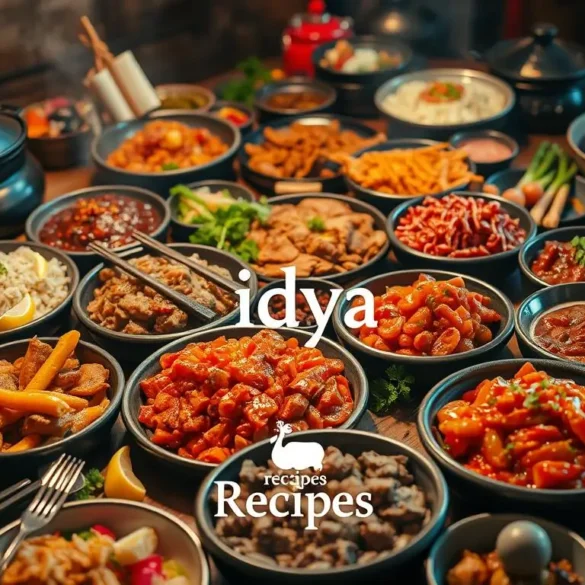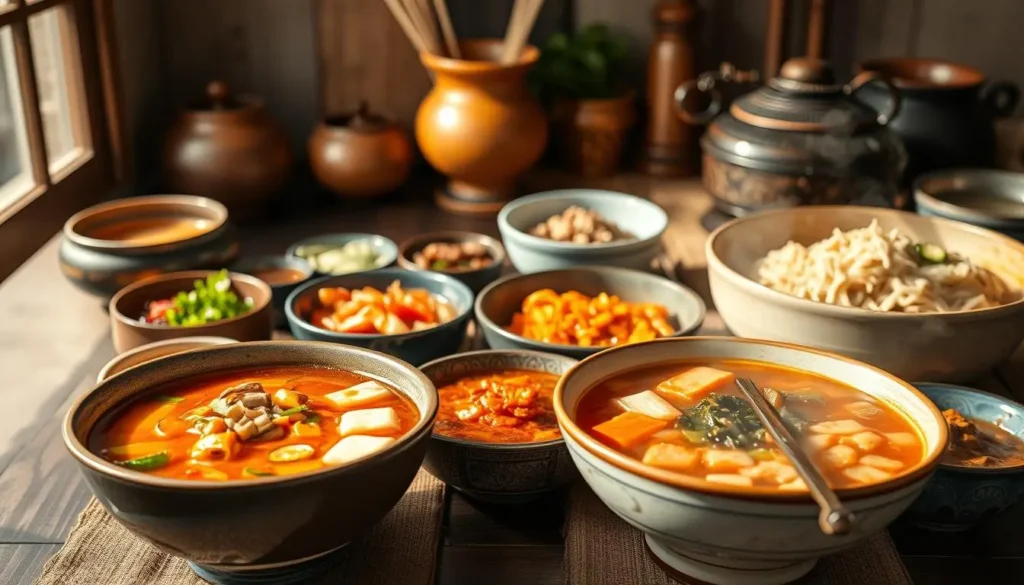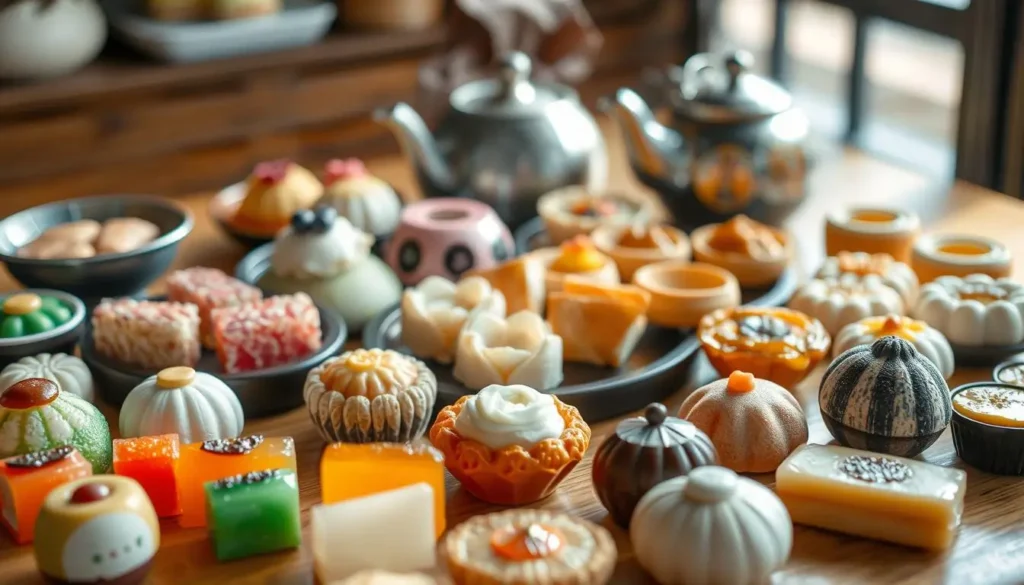
Ingredients
- 500 grams beef sirloin or ribeye, thinly sliced
- 2 tablespoons soy sauce
- 1 tablespoon sesame oil
- 1 tablespoon rice vinegar
- 1 tablespoon brown sugar
- 3 cloves garlic, minced
- 1 tablespoon grated ginger
- 1/2 onion, thinly sliced
- 1/2 teaspoon ground black pepper
- 1/4 cup sliced green onions
- 1 tablespoon sesame seeds
- 2 tablespoons vegetable oil
- 1 tablespoon gochujang (Korean chili paste)
- 1 tablespoon water
- Cooked rice for serving
Instructions
In a bowl, combine soy sauce, sesame oil, rice vinegar, brown sugar, minced garlic, grated ginger, black pepper, and gochujang. Stir to mix well.
Add the thinly sliced beef to the bowl and marinate for at least 15 minutes (up to 2 hours for more flavor).
Heat a large pan or skillet over medium-high heat and add vegetable oil.
Once the oil is hot, add the marinated beef and cook for 5-7 minutes, stirring occasionally, until the beef is browned and cooked through.
Add sliced onion to the pan and cook for another 3-4 minutes until the onion becomes soft and translucent.
Once done, remove from heat and sprinkle with sliced green onions and sesame seeds.
Serve hot with cooked rice on the side.
Notes
For a spicier version, increase the amount of gochujang or add sliced fresh chili peppers. Serve with kimchi for a true Korean meal experience.
Table of Contents
Ready to make your kitchen a Korean food paradise? Korean recipes bring exciting flavors to your table. They can turn any meal into a special event.
Thank you for reading this post, don't forget to subscribe!Making Korean meals at home is easier than you think. You just need simple techniques and common ingredients. This way, you can make dishes that wow your loved ones. Korean food is all about bold tastes and healthy ingredients.
This guide will show you how to make real Korean dishes at home. It doesn’t matter if you’re new to cooking or already skilled. These recipes will encourage you to dive into Korean food’s rich flavors.
Key Takeaways
- Korean recipes are surprisingly easy to make at home
- Essential ingredients can be found in most grocery stores
- Techniques are straightforward and adaptable
- Flavors range from spicy to savory and sweet
- Homemade Korean meals offer healthy and delicious options
Introduction to Korean Cuisine
Explore the world of traditional Korean food, a journey that will excite your taste buds. Authentic Korean cuisine is a vibrant and unique experience. It’s more than just cooking meals.
Korean food is a perfect mix of flavors, textures, and nutrition. It reflects centuries of culture and respect for ingredients.
What Makes Korean Food Unique?
Several things make authentic Korean cuisine special:
- Emphasis on fermented foods
- Complex flavor profiles
- Nutritional balance in every meal
- Communal dining experience
Key Ingredients in Korean Cooking
Traditional Korean food is built on key ingredients:
- Gochugaru: Korean red pepper flakes
- Gochujang: Fermented red chili paste
- Doenjang: Fermented soybean paste
- Sesame oil
- Garlic
Popular Korean Cooking Methods
Korean chefs use many cooking techniques to improve flavor and keep nutrients:
- Grilling (Korean BBQ style)
- Fermentation
- Stir-frying
- Steaming
“Korean cuisine is not just about eating, it’s about experiencing a cultural story through food.” – Korean Culinary Expert
Learning about these elements will help you understand the depth of authentic Korean cuisine. It prepares you for your culinary adventure.
Classic Korean Dishes to Start With
Exploring Korean dishes opens a world of vibrant flavors. Korean cuisine offers a wide range of delicious recipes. These dishes will make your home cooking exciting and introduce you to a rich tradition.
Kimchi: A Fermented Treasure
Kimchi is the heart of Korean cuisine. It’s a spicy fermented vegetable dish full of probiotics and flavor. This iconic dish is made with napa cabbage, red pepper flakes, garlic, ginger, and green onions.
You can enjoy kimchi as a side dish or add it to recipes. It brings depth and tanginess to your meals.
Bibimbap: A Colorful Rice Bowl
Bibimbap is a great way to start with Korean cooking. This vibrant rice bowl combines multiple ingredients in a stunning and balanced meal. It includes rice, vegetables, protein, and spicy gochujang sauce.
Bibimbap is all about customization. You can make it your own with your favorite ingredients.
Korean BBQ: A Fun Dining Experience
Korean BBQ recipes add excitement to your meals. These interactive meals involve grilling marinated meats at your table. Key elements include high-quality meat, flavorful marinades, side dishes, and the interactive cooking process.
Mastering these classic dishes will give you insight into Korean cuisine’s rich flavors and cooking techniques. It’s loved worldwide for good reason.
Soups and Stews in Korean Cooking
Korean cuisine is famous for its warm soups and stews. These dishes are more than meals; they’re a way to connect with others through shared tastes and traditions.

Soups are a big part of Korean meals. They offer nourishing and tasty options that highlight the variety of spicy korean recipes. Each stew has its own story, with ingredients and cooking methods passed down through generations.
Kimchi Jjigae: Comfort in a Bowl
Kimchi jjigae is the ultimate comfort food in Korea. It mixes tangy kimchi with tender pork or tofu. This creates a rich, spicy taste that warms you up.
- Key ingredients: Kimchi, pork or tofu
- Cooking time: Approximately 30 minutes
- Best served: Hot with a side of steamed rice
Sundubu Jjigae: Spicy Soft Tofu Stew
Sundubu jjigae is a favorite spicy korean recipe. It features soft tofu in a fiery broth. The soft tofu’s texture is perfect with the bold, vibrant flavors of gochugaru (red pepper flakes) and other seasonings.
Galbitang: Tender Short Rib Soup
Galbitang is a hearty option among korean recipes. It uses slow-simmered beef short ribs. This soup has deep, complex flavors that take hours to develop.
“Korean soups are not just food, they’re a culinary journey of flavor and tradition.”
Creating Flavorful Sauces and Marinades
Authentic Korean cuisine is all about rich, complex sauces. These sauces turn simple ingredients into amazing dishes. Learning about these sauces is key to making great Korean BBQ and traditional dishes.
Korean sauces are more than just seasonings. They are a culinary art that adds depth and character to every dish. Each sauce has its own story of fermentation, tradition, and unique flavors.
Gochujang: The Essential Red Chili Paste
Gochujang is a must-have in Korean cooking. It offers a mix of spicy, sweet, and umami flavors. This fermented red chili paste makes Korean BBQ and marinades incredibly rich.
- Deep red color with smooth texture
- Made from red chili powder, glutinous rice, fermented soybeans
- Aged for several months to develop complex flavor
Doenjang: Fermented Soybean Paste
Doenjang is another key sauce in Korean cooking. It adds intense savory flavors to dishes. Its rich, earthy taste comes from fermented soybeans.
| Characteristic | Description |
|---|---|
| Texture | Thick and chunky |
| Flavor Profile | Deeply umami, salty, slightly nutty |
| Common Uses | Stews, marinades, dipping sauces |
Yangnyeom: Korean Marinade for Meats
Yangnyeom marinades are the secret to great Korean BBQ. They add layers of flavor to meats, making each bite unforgettable.
- Combine soy sauce
- Add minced garlic
- Mix in sesame oil
- Include grated ginger
- Optional: Add gochujang for heat
Mastering these sauces will let you experience the true essence of Korean cuisine in your kitchen.
Vegetarian and Vegan Korean Recipes
Korean cuisine is a treasure trove for those who love vegetarian and vegan food. It’s not just about meat; it’s full of amazing plant-based dishes that are both healthy and tasty.
Trying vegetarian Korean recipes lets you dive into the rich flavors and culture of Korean cooking. You don’t have to give up your dietary choices. These dishes show how versatile plant-based ingredients can be in traditional Korean cooking.
Tofu Banchan: Simple Sides You’ll Love
Tofu banchan is a great way to start exploring vegetarian Korean dishes. These side dishes prove that tofu is a fantastic protein source. You can make these easy Korean dishes with just a few ingredients:
- Soft tofu seasoned with gochugaru (red pepper flakes)
- Crispy pan-fried tofu with soy sauce glaze
- Marinated cold tofu with fresh herbs
Japchae: Stir-Fried Sweet Potato Noodles
Japchae is a favorite vegetarian Korean dish that’s both vibrant and filling. It’s made with sweet potato noodles and various vegetables. This stir-fry offers a great mix of textures and tastes.
Vegetable Kimchi: Customizable and Delicious
Vegetable kimchi is a great way to learn about Korean food preservation. You can pick your favorite vegetables to make a tangy and spicy side dish. It’s perfect for any meal.
Trying these vegetarian Korean recipes will open up new culinary adventures. You’ll discover the amazing world of plant-based Korean cooking.
Korean Street Food You Can Make at Home
Korean street food adds excitement and flavor to your kitchen. These dishes bring the lively street food culture of Korea to your home. They are fun to make and taste amazing, whether you’re new to cooking or a pro.

Street food is at the heart of Korean food culture. These quick meals are full of bold flavors and creative mixes. Here are three iconic street food recipes you can make at home.
Tteokbokki: Spicy Rice Cakes
Tteokbokki is a favorite street food with chewy rice cakes and spicy red sauce. You can adjust the spice level to your liking. Here’s what you need:
- Cylindrical rice cakes
- Gochujang (Korean red chili paste)
- Soy sauce
- Sugar
- Green onions for garnish
Hotteok: Sweet Pancakes Filled with Brown Sugar
Hotteok are warm, crispy pancakes loved in winter. They have a golden outside and a sweet, gooey inside. The filling usually includes:
- Brown sugar
- Chopped nuts
- Cinnamon
Kimbap: Korean Sushi Rolls
Kimbap is Korea’s version of sushi. These rolls can be filled with many things, making them fun to make. Popular fillings are:
- Cooked vegetables
- Seasoned meat
- Pickled radish
- Egg
By making these korean recipes at home, you can enjoy the real street food experience. Try these dishes and explore the joy of Korean cooking!
Exploring Regional Korean Dishes
Korean food is a colorful mix of tastes from different areas. Each part of Korea has its own special dishes, showing the wide range of Korean food. From the sea to the mountains, each dish reflects the local tastes and traditions.
Jeonju Bibimbap: The Authentic Version
Jeonju, in southwestern Korea, is famous for its perfect bibimbap. This city makes the classic rice bowl dish special by choosing each ingredient carefully. Chefs here use:
- Locally sourced vegetables
- High-quality rice
- Artfully prepared proteins
- Handmade gochujang sauce
“In Jeonju, bibimbap is not just a dish – it’s an art form that tells the story of our region.” – Local Jeonju Chef
Busan-style Seshimi: Fresh and Flavorful
Busan, a coastal city, is a paradise for seafood fans. Its seshimi (Korean-style sashimi) is known for its freshness. Fishermen bring in daily catches that are turned into delicious, ocean-flavored dishes.
Gwangju’s Famous Tteokgalbi
Gwangju is a meat lover’s paradise with its tteokgalbi. This dish makes minced beef into juicy grilled patties full of flavor. Chefs here mix old techniques with new cooking methods, making a dish that shows the heart of Korean food.
Trying these regional dishes lets you see the depth and variety of Korean food. Each bite shares a story of local ingredients, culture, and cooking skill.
The Art of Korean Side Dishes (Banchan)
Banchan is at the heart of Korean food, making every meal lively. These small dishes add flavor, texture, and nutrition to meals. They are key to enjoying Korean cuisine at home.
Korean food is all about variety through banchan. Each dish shares a story of local ingredients and cooking methods. These small plates are more than just sides; they make the meal special.
Essential Banchan for Every Meal
Here are some must-have side dishes for your banchan:
- Kimchi: Fermented vegetable staple
- Japchae: Stir-fried glass noodles
- Gyeran-mari: Rolled egg omelet
- Gamja-jorim: Braised potato cubes
- Namul: Seasoned vegetable dishes
Create Your Own Banchan Platter
Building a banchan platter is all about color, taste, and texture. Choose a mix of raw, pickled, and cooked items for a feast for the eyes and taste buds. Pick dishes that work well together without being too much.
Storing and Serving Banchan
Keeping banchan fresh is important. Store them in airtight containers in the fridge. Serve them in small dishes around the main dish. This lets everyone try a bit of everything.
“Banchan is not just food, it’s a culinary art form that represents Korean hospitality and cultural richness.” – Korean Culinary Expert
The Sweet Side of Korean Cuisine
Korean desserts are a journey of unique flavors and textures. They show the country’s rich culinary traditions. You’ll find everything from shaved ice treats to traditional rice cakes, offering a mix of refreshing and comforting desserts.

Patbingsu: Shaved Ice Delight
Patbingsu is a quintessential Korean summer dessert. It’s a cool treat made with finely shaved ice and various toppings. Making this dessert at home is easy with simple ingredients.
- Crushed ice base
- Sweet red beans
- Fresh fruit chunks
- Condensed milk drizzle
Songpyeon: Traditional Rice Cake
Songpyeon is a beloved Korean recipe tied to cultural celebrations. These half-moon shaped rice cakes are made during Chuseok, Korea’s harvest festival. They’re filled with sweet ingredients, offering a taste of tradition.
| Ingredient | Quantity | Purpose |
|---|---|---|
| Rice flour | 2 cups | Base dough |
| Sesame seeds | 1/4 cup | Filling |
| Pine nuts | 2 tbsp | Additional flavor |
Korean Pear Salad: A Refreshing Dessert
Korean pear salad is a light and elegant dessert. It combines crisp pears with a honey dressing. This easy dish is both healthy and delicious.
“Desserts in Korean cuisine are not just sweet treats, but a celebration of seasonal ingredients and cultural traditions.” – Korean Culinary Expert
Pairing Drinks with Korean Meals
Korean cuisine is full of drinks that match perfectly with its food. Understanding Korean drink culture is key to enjoying traditional meals. From spirits to non-alcoholic drinks, Korean beverages add to the dining experience.
Traditional Korean Alcohols: Soju and Makgeolli
Korean drinks are more than just drinks; they’re cultural experiences. Soju, a clear spirit, is Korea’s favorite drink. It’s made from rice or sweet potatoes and goes well with grilled meats.
- Soju: Clear, smooth spirit
- Makgeolli: Milky rice wine
- Alcohol content ranges from 16-25%
Popular Non-Alcoholic Beverages
Korean non-alcoholic drinks are unique and refreshing. Sikhye, a sweet rice drink, is a great way to end a meal. Sujeonggwa, a cinnamon punch, is warm and aromatic, perfect for cleansing your palate.
Tea Culture in Korea
Tea is more than a drink in Korea; it’s a sign of hospitality and connection. Green tea, barley tea, and ginseng tea are favorites that highlight Korean tea traditions.
- Green tea: Healthy and aromatic
- Barley tea: Cooling and refreshing
- Ginseng tea: Medicinal and energizing
“Drinking in Korea is not just about the beverage, but the experience of sharing and connection.”
Tips for Cooking Authentic Korean Meals at Home
Starting with homemade Korean meals might seem hard, but it’s easy with the right tools and knowledge. This guide will turn your kitchen into a Korean cooking paradise.
To cook delicious Korean dishes, you need special equipment and ingredients. Let’s look at how to set up for success in the kitchen.
Essential Kitchen Tools for Korean Cooking
Every Korean home chef needs a few key tools for traditional dishes:
- Dolsot (Stone Pot): Perfect for making crispy bibimbap
- Korean BBQ grill pan
- Sharp chef’s knife
- Kimchi fermentation containers
- Rice cooker
Sourcing Authentic Korean Ingredients
Finding real Korean ingredients makes your meals amazing. Here are some places to find them:
| Ingredient Type | Best Purchasing Locations |
|---|---|
| Gochujang | Asian grocery stores, online specialty markets |
| Doenjang | Korean supermarkets, international food sections |
| Specialty Seasonings | Amazon, H Mart, local Asian markets |
Adjusting Flavors to Your Taste
Authentic Korean cuisine is about balance. Feel free to tweak recipes to your liking. Start with traditional recipes and then adjust spice, salt, or sweetness to your taste.
“Cooking is about personal expression – make each dish your own!” – Korean Cooking Experts
Mastering Korean cooking takes time. Enjoy the journey, be bold in trying new things, and relish in making tasty meals that feel like a trip to Korea.
Conclusion: Savoring Homemade Korean Delights
Your journey into Korean recipes has been exciting. You’ve discovered vibrant flavors and cooking techniques. These turn simple meals into special experiences. Homemade Korean meals celebrate culture, tradition, and creativity.
Learning Korean cooking opens new kitchen possibilities. You’ve likely made kimchi, perfected bibimbap, or tried complex marinades. Each recipe helps you become a more confident and adventurous cook. The skills you’ve gained will help you explore more Korean recipes.
Encouragement to Explore New Recipes
Don’t stop exploring—keep trying new techniques and ingredients. Korean cooking has a world of flavors to discover. Start with simple recipes and build your skills. Remember, every great chef started as a beginner, and your passion will guide you.
Join the Korean Cooking Community Online
Connect with others who love Korean cuisine. Online forums, social media groups, and cooking websites offer inspiration and support. Share your successes, learn from others, and stay motivated to keep exploring.
Share Your Korean Culinary Creations!
Your unique touch makes each dish special. Share your photos and recipes with friends. Your kitchen is now a doorway to Korea’s rich culinary traditions, one delicious bite at a time.
FAQ
What are some essential ingredients for Korean cooking?
Key ingredients include gochugaru (red pepper flakes), gochujang (red chili paste), and doenjang (fermented soybean paste). Also, sesame oil, soy sauce, garlic, and kimchi are important. These ingredients give Korean dishes their unique flavors.
Is Korean food very spicy?
Many Korean dishes are spicy, but not all are very hot. You can adjust the spice by using less gochugaru or gochujang. Korean food offers a range of flavors, from mild to spicy, so you can choose what you like.
How can I make authentic Korean food at home?
Start by getting the right Korean ingredients. You’ll also need some special kitchen tools like a stone pot or grill pan. Try simple recipes like bibimbap or Korean BBQ. Use authentic recipes from cookbooks or trusted websites, and feel free to experiment.
Are there vegetarian options in Korean cuisine?
Yes! Korean cuisine has many vegetarian dishes. Try japchae (stir-fried sweet potato noodles), tofu banchan, vegetable kimchi, and vegetable stews. Many side dishes (banchan) are vegetarian and can be part of a plant-based diet.
What is the most popular Korean dish for beginners?
Bibimbap is a great choice for beginners. It’s a colorful rice bowl with various vegetables, proteins, and sauces. It’s easy to make and lets you get creative with ingredients and presentation.
Where can I find Korean ingredients?
You can find Korean ingredients in Asian grocery stores, international markets, or specialty food stores. Online retailers like H Mart, Zion Market, and Amazon also offer a wide selection that can be delivered to your home.
How important is fermentation in Korean cooking?
Fermentation is very important in Korean cuisine. Kimchi is a famous fermented food. Fermented ingredients like gochujang, doenjang, and kimchi add unique flavors and health benefits to many dishes.
Can I make Korean BBQ at home?
Yes! You can make Korean BBQ at home with a grill pan or outdoor grill. Use traditional Korean marinades for meats like bulgogi or galbi. Serve with side dishes and banchan for a real Korean BBQ experience.


